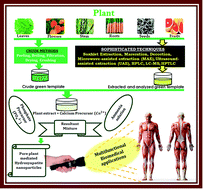A plant-mediated synthesis of nanostructured hydroxyapatite for biomedical applications: a review
Abstract
The engineering of calcium-based phosphate materials at the nanoscale gains several unique properties compared to the bulky state. The effort to scale down, e.g., from bulky state to nanoscale in order to control the morphology and improve structural properties requires the use of varying reagents that can be detrimental to the environment. A typical example of these materials is hydroxyapatite (HAp), one of the well-known calcium phosphate materials, which has a close resemblance to human bone tissue. HAp has valuable applications in catalysis, drug delivery, bone and dental implant formation, and adsorption. Hydroxyapatite-based nanomaterials synthesized through conventional routes make use of reagents that are not environmental friendly and are very costly. Since the current research trends are geared towards producing/synthesizing nanomaterials through an eco-friendly approach, there is the need to consider the techniques and reagents involved in the synthesis of HAp. This review touches on the possible replacement of such synthetic chemical reagents, synthesis routes, and toxic capping agents with plant extracts for synthesizing HAp-based nanomaterials for multi-functional applications. The influence of biomolecules from plants on synthesized HAps and the attainable mechanism during these green approaches are discussed. Viable future modifications of the methods used to obtain extracts from plants are also studied.

- This article is part of the themed collection: 2020 Reviews in RSC Advances


 Please wait while we load your content...
Please wait while we load your content...